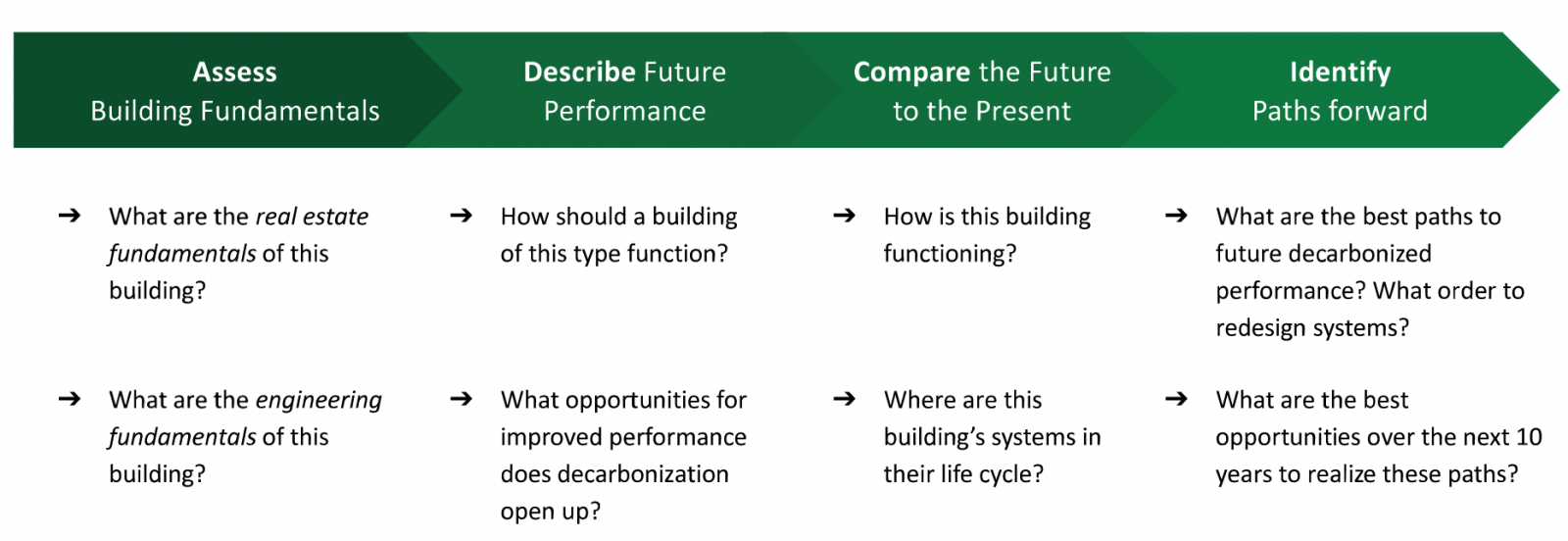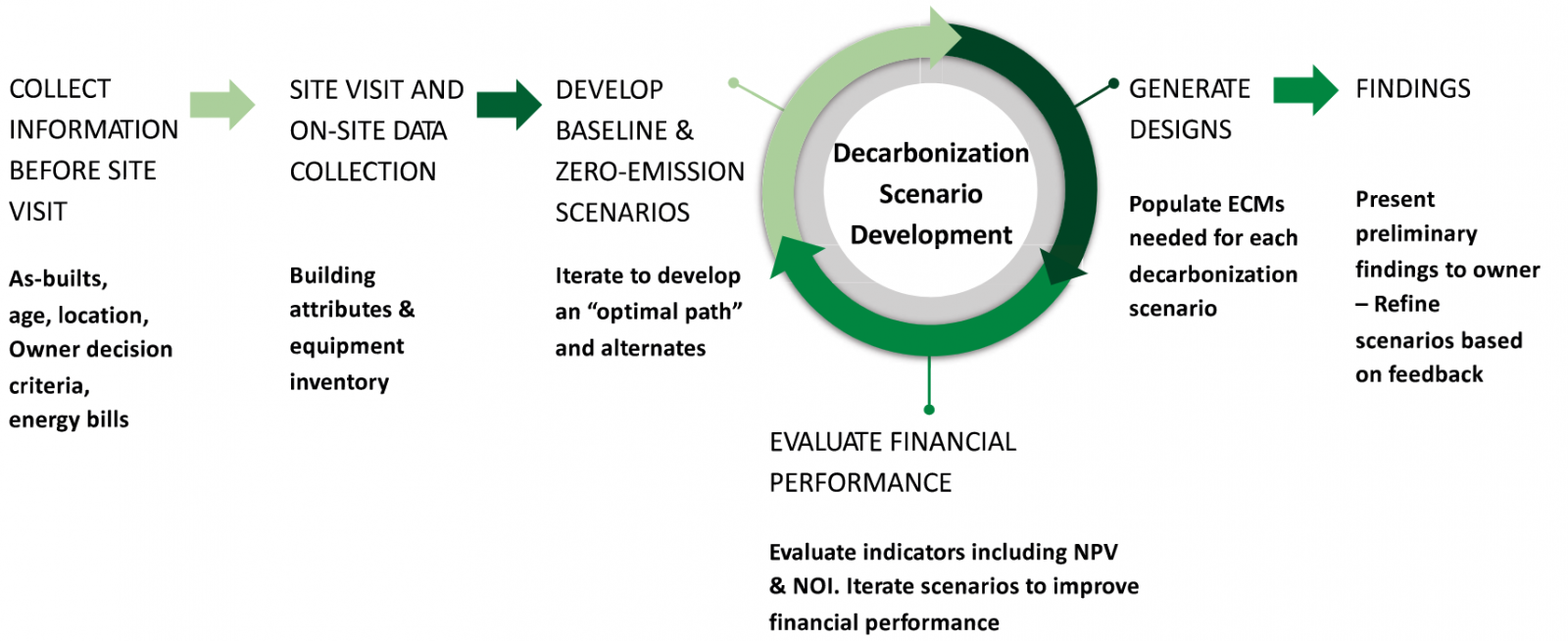A Financial Plan for Managing Carbon Emissions and Electrification
Overview: The San Francisco Department of the Environment (SFE) commissioned the development of a tool to support building owners as they manage the energy use and invest in reduction or elimination of carbon emissions associated with their buildings over the coming years. The tool was subsequently improved through large-scale deployment and user-testing in NYSERDA's Empire Building Challenge - which provided key insights about Resource Efficient Electrification.
Decarbonization must be accomplished within the lifespan of today’s existing buildings – so the key questions are “How?” and “When” to decarbonize, not “Will we?”. SDA facilitates answering these questions through systematic identification and planning for financially advantageous times to pursue environmentally beneficial building upgrades, including redesign of building systems. The keys to this approach:
- Acknowledge it is inevitable that equipment must eventually be replaced.
- To facilitate effective decisions, opportunities for upgrade must be grounded in real estate management and decisionmaking practices.
The SDA is currently accepted as an option for compliance with the audit requirement of the Existing Commercial Buildings Ordinance; the effort required for an SDA is intended to be similar to an ASHRAE Level 2 audit, so this alternative path is recommended primarily for buildings 50,000 square feet or larger in lieu of an ASHRAE Level 2 audit.
Background: Most asset management strategies involve forecasting capital and operational expenses, consistent with the owner’s investment strategy. Such forecasts typically include reactive plans to replace equipment at end of life or to avoid equipment replacement altogether. Envisioning how the building should ultimately perform and proactively formulating paths to the redesign and eventual replacement of building systems offers the opportunity to act at the time and place of your choosing. In the absence of planning, opportunities for better returns and less tenant disruption may be missed, locking in higher operating costs and carbon emissions.
Engineers have the expertise to identify forthcoming efficiency investment opportunities, but traditional analysis centered on “payback” implicitly assumes a “do nothing” baseline that has zero cost. In reality, equipment will need repair and replacement, and there is a cost to inaction.
In a Strategic Decarbonization Assessment, an engineer will propose smart, proactive improvement strategies that the owner can implement at advantageous times over the next 5 to 10 years to significantly reduce building carbon emissions and improve returns. Opportunistic building owners will incorporate these recommendations into their asset management plans to reduce operational expenses and increase net operating income.
If you are interested in more info on the SDA, contact existingbuildings@sfgov.org.
SDA Key Questions:
- How should this building perform?
- What is the path to get there? When?
Traditional energy audits compel engineers to consider how a building’s performance could be improved within the owner's “payback threshold”, an arbitrary length of time that can be as short as a single year. In a Strategic Decarbonization Assessment, engineers consider the building’s fundamentals, like location, space use, market position, as well as inherent physical constraints, and use that information to propose how the building owner should stage investments over time to realize the building’s ideal future performance and elimination of GHG emissions. These proactive scenarios undergo discounted cash flow analyses to inform which options are more effective —financially and for the planet.

The process starts by forecasting a baseline scenario and multiple alternatives. Most commonly, the baseline represents reactive management: replace equipment when it burns out. The financial implications of the baseline are compared to scenarios for proactive management: replacing equipment when it is advantageous in the context of the owner’s investment objectives.
Start Planning!
For questions, comments, and more info on the SDA, contact existingbuildings@sfgov.org.
How it Works
Data requirements and engineering analysis for SDA are derived from ASHRAE 211 (2018) normative forms, but the approach is more consistent with fundamental real estate industry practices, processes, and standards.
The analytic method of comparing a reactive baseline to proactive management scenarios combines concepts from the Property Condition Assessment (PCA) with the ASHRAE Level 2 audit process. PCA is a forward-looking assessment that includes estimated timelines for future costs, such as equipment repair and replacement – but a PCA commonly stops there, seeking only to set expectations for future costs.
SDA picks up where a PCA leaves off. The engineer preparing an SDA uses the “fix it when it breaks” baseline as a platform to propose more effective paths forward – from a reactive baseline to proactive – strategic – scenarios for decarbonization.

From the engineer’s perspective, data collection for SDA is similar to an ASHRAE Level 2 audit. The engineer performs an equipment inventory as in the ASHRAE 211-2018 normative forms, cataloging at least 80 percent of the building’s HVAC and water heating energy use. This equipment inventory allows for the estimation of remaining useful life and generation of a timeline for replacement of major equipment.
The SDA calculator helps the engineer generate a baseline financial operating statement over the owner’s defined holding period, including expected equipment repair and replacement. The financial analysis incorporates operational information about the building (such as expected rent and operating expenses). The SDA calculator provides reasonable default operational characteristics for San Francisco; these values can optionally be revised if the owner desires. However, the value of SDA is the comparison of scenarios where real estate fundamentals are held constant. Strategic assessment based on reasonable (default) operational information is sufficient to illuminate the impact of a scenario compared to the reactive baseline.
The engineer creates proactive scenarios of energy conservation measures (ECMs) that represent a better path forward than the reactive baseline. Proposed costs and benefits for each scenario are analyzed and presented in terms of annual net operating income and net present value over the owner’s holding period for the building compared to the baseline reactive scenario.
Communication is essential to this process: to develop an effective strategy for a building, the engineer must present preliminary findings to ownership, get feedback, and incorporate that feedback into the assessment. Decarbonization of large buildings as a “one and done” project will be exceptional – likely limited to new construction and rehabilitation during asset repositioning. The discussion itself holds much of the value; the process of developing and refining options is essential to strategic decarbonization.
Today the SDA calculator is a spreadsheet template. Since the data requirements are derived from ASHRAE 211, the inputs are also substantially consistent with compatible tools, including US DOE’s Audit Template. An online version of the process utilizing BuildingSync XML and ideally DOE Audit Template is expected in the future.
Credits: The SDA tool was developed and refined by Arup and Ember Strategies. The SDA concept was developed through the implementation of Ember Strategies’ Empowerment Method with support from the Energy Foundation.